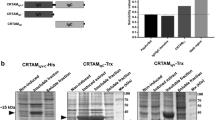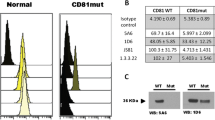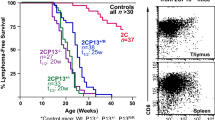Abstract
The generation of an antigen-specific T-cell response requires that the T lymphocyte receive two signals from the antigen presenting cell. The specificity of this response is provided by antigen presented to the T lymphocyte and involves stimulation of the T lymphocyte via the T-cell receptor (TCR)/CD3 complex. The second, or costimulatory signal, can be provided by ligation of the B-lymphocyte activation antigens B7-1 (CD80) and B7.2 (CD86) to TCR antigen CD28. The cDNAs for both CD80 and CD86 have been isolated and are predicted to encode type 1 membrane proteins of the immunoglobulin (Ig) superfamily. The predicted protein is composed of a signal peptide followed by two Ig-like extracellular domains, a transmembrane domain, and a cytoplasmic tail. Here we report that the genomic organization of CD86 reflects its functional structure, and is similar to that oound for CD80. The gene is composed of eight exons which span more than 22 kilobases. The predicted protein functional domains of signal peptide, extracellular IgV- and Ig-like regions, and transmembrane domain coincide with the genomic structure. Two independent sequences had been reported for CD86 cDNA which differed in their 5′-untranslated (UT) regions. We find CD86 exons 1 and 2 correspond to these alternate 5′UT sequences. Splicing of exon 1 or 2 with the signal peptide encoding exon 3 would produce mRNA transcripts complementary to the reported cDNA clones. Exons 4 and 5 correspond to IgV- and IgC-like extracellular domains, respectively. Exon 6 encodes the transmembrane region and beginning of the cytoplasmic tail. Exons 7 and 8 encode the remainder of the cytoplasmic tail and 3′UT sequences.
Similar content being viewed by others
References
Azuma, M., Ito, D., Yagita, H., Okumura, K., Phillips, J. H., Lanler, L. L., and Somoza, C. B70 antigen is a second ligand for CTLA-4 and CD28. Nature 366: 76–79, 1993
Blazer, B. R., Taylor, P. A., Linsley, P. S., and Vallera, D. A. In vivo blockade of CD28/CTLA4: B7/BB1 interaction with CTLA4Ig reduces lethal murine graft-versus-host disease across the major histocompatibility complex barrier in mice. Blood 83: 3815–3825, 1994
Borriello, F., Freeman, G. J., Edelhoff, S., Disteche, C. M., Nadler, L. M., and Sharpe, A. H. Characterization of the murine B7–1 genomic locus reveals an additional exon encoding an alternative cytoplasmic domain and a chromosomal location of chromosome 16, band B5. J Immunol 153: 5038–5048, 1994
Boussiotis, V. A., Freeman, G. J., Gribben, J. G., Daley, J., Gray, G., and Nadler, L. M. Activated human B lymphocytes express three CTLA-4 counterreceptors that costimulate T-cell activation. Proc Natl Acad Sci USA 90: 11059–11063, 1993
Engel, P., Gribben, J. G., Freeman, G. J., Zhou, L. J., Nozawa, Y., Abe, M., Nadler, L. M., Wakasa, H., and Tedder, T. F. The B7–2 (B70) costimulatory molecule expressed by monocytes and activated B lymphocytes is the CD86 differentiation antigen. Blood 84: 1402–1407, 1994
Freeman, G. J., Gray, G. S., Gimmi, C. D., Lombar, D. B., Zhou, L. J., White, M., Fingeroth, J. D., Gribben, J. G., and Nadler, L. M. Structure, expression, and T-cell costimulatory activity of the murine homologue of the human B lymphocyte activation antigen B7. J Exp Med 174: 625–631, 1991
Freeman, G. J., Gribben, J. G., Boussiotis, V. A., Restivo Jr, V. A., Lombard, L. A., Gray, G. S., and Nadler, L. M. Cloning of B7–2: a CTLA-4 counter-receptor that costimulates human T cell proliferation. Science 262: 909–911, 1993
Gimmi, C. D., Freeman, G. J., Gribben, J. G., Sugita, K., Freedman, A. S., Morimoto, C., and Nadler, L. M. B cell surface antigen B7 provides a costimulatory signal that induces T cells to proliferate and secrete IL-2. Proc Natl Acad Sci USA 88: 6575–6579, 1991
Harding, F. A., McArthur, J. G., Gross, J. A., Raulet, D. H., and Allison, J. P. CD28-mediated signalling co-stimulates murine T cells and prevents induction of anergy in T-cell clones. Nature 356: 607–609, 1992
Jenkins, M. J. and Schwartz, R. H. Antigen presentation by chemically modified splenocytes induces antigen-specific T cell unresponsiveness in vitro and in vivo. J Exp Med 165: 302–319, 1987
June, C. H. Signal transduction in T cells. Curr Opin Immunol 3: 287–293, 1991
Klausner, R. D. and Samelson, L. E. T cell antigen receptor activation pathways: the tyrosine kinase connection. Cell 64: 875–878, 1991
Koulova, L., Clark, E. A., Shu, G., and Dupont, B. The CD28 ligand B7/BB1 provides a costimulatory signal for alloactivation of CD4+ T cells. J Exp Med 173: 759–762, 1991
Larsen, C. P., Ritchie, S. C., Hendrix, R., Linsley, P. S., Hathcock, K. S., Hodes, R. J., Lowry, R. P., and Pearson, T. C. Regulation of immunostimulatory function and costimulatory molecule (B7–1 and B7–2) expression on murine dendritic cells. J Immunol 152: 5208–5219, 1994
Lenschow, D. J., Zeng, Y., Thistlewaite, J. R., Montag, A., Brady, W., Gibson, M. G., Linsley, P. S., and Bluestone, J. A. Long term survival of xenogeneic pancreatic islets induced by CTLA4Ig. Science 257: 789–792, 1992
Lenschow, D. J., Sperling, A. I., Cooke, M. P., Freeman, G., Rhee, L., Decker, D. C., Gray, G., Nadler, L. M., Goodnow, C. C., and Bluestone, J. A. Differential up-regulation of the B7–1 and B7–2 costimulatory molecules after Ig receptor engagement by antigen. J Immunol 153: 1990–1997, 1994
Linsley, P. S., Brady, W., Grosmaire, L. S., Aruffo, A., Damle, N. K., and Ledbetter, J. A. Binding of the B cell activation antigen B7 to CD28 costimulates T cell proliferation and IL-2 mRNA accumulation. J Exp Med 173: 721–730, 1991 a
Linsley, P. S., Brady, W., Urnes, M., Grosmaire, L. S., Damle, N. K., and Ledbetter, J. A. CTLA-4 is a second receptor for the B cell activation antigen B7. J Exp Med 174: 561–569, 1991 b
Nisbet-Brown, E. R., Lee, J. W., Cheung, R. K., and Gelfand, E. W. Antigen-specific and non specific mitogenic signals in the activation of human T cell clones. J Immunol 138: 3713–3719, 1987
Pearson, T. C., Alexander, D. Z., Winn, K. J., Linsley, P. S., Lowry, R. P., and Larsen, C. P. Transplantation tolerance induced by CTLA4Ig. Transplantation 57: 1701–1706, 1994
Pescovitz, M. D., Yang, R., Liu, Q., Collins, M. H., and Grosfeld, J. L. CD28-pathway blockade with CTLA4Ig leads to prolongation of small bowel transplant survival in rats. Transplant Proc 26: 1618–1619, 1994
Reiser, H., Freeman, G. J., Razi-Wolf, Z., Gimmi, C. D., Benacerrof, B., and Nadler, L. M. Murine B7 antigen provides an efficient costimulatory signal for activation of murine T lymphocytes via the T-cell receptor/CD3 complex. Proc Natl Acad Sci USA 89: 271–275, 1992
Selvakumar, A., Mohanraj, B. K., Eddy, R. L., Shows, T. B., White, P. C., and Dupont, B. Genomic organization and chromosomal location of the human gene encoding the B-lymphocyte activation antigen B7. Immunogenetics 36: 175–181, 1992
Shapiro, M. B. and Senapathy, P. RNA splice junctions of different classes of eukaryotes: sequence statistics and functional implications in gene expression. Nucleic Acids Res 15: 7155–7174, 1987
Southern, E. M. Detection of specific sequences among DNA fragments separated by gel electrophoresis. J Mol Biol 98: 503–517, 1975
Stenberg, Nat. L. A bacteriophage P1 cloning system for the isolation, amplification and recovery of DNA fragments as large as 100 kb. Proc Natl Acad Sci USA 83: 103–107, 1990
Turka, L. A., Linsley, P. S., Lin, H., Brady, W., Leiden, J. M., Wei, R. Q., Gibson, M. L., Zheng, X. G., Myrdal, S., Gordon, D., Bailey, T., Bolling, S. T., and Thompson, C. B. T-cell activation by the CD28 ligand B7 is required for cardiac allograft rejection in vivo. Proc Natl Acad Sci USA 89: 11 102–11 105, 1992
Umetsu, D. T., Katzen, D., Chatila, T., Miller, R., Jabara, H. H., Maher, M., Oettgen, H., Terhost, C., and Geha, R. S. Requirements for activation of human peripheral blood T cells by mouse monoclonal antibody to CD3. Clin Immunol Immunopathol 43: 48–64, 1987
Author information
Authors and Affiliations
Additional information
The nucleotide sequence data reported in this Papershave been submitted to the EMBL/GenBank nucleotide sequence databases and have been assigned the accession numbers U17715 (HSB72S1), U17716 (HSB72S2), U17717 (HSB72S3), U17718 (HSB72S4), U17719 (HSB72S5), U17720 (HSB72S6), U17721 (HSB72S7), and U17722 (HSB72S8)
Rights and permissions
About this article
Cite this article
Jellis, C.L., Wang, S.S., Rennert, P. et al. Genomic organization of the gene coding for the costimulatory human B-lymphocyte antigen B7-2 (CD86). Immunogenetics 42, 85–89 (1995). https://doi.org/10.1007/BF00178582
Received:
Revised:
Issue Date:
DOI: https://doi.org/10.1007/BF00178582




